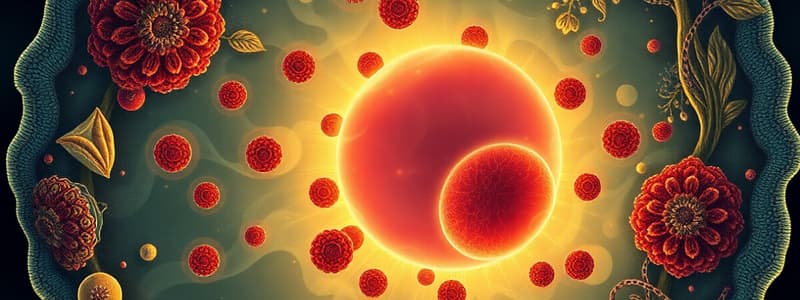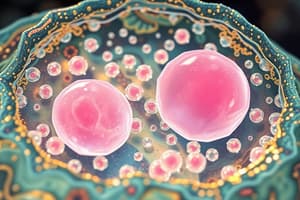Podcast
Questions and Answers
What is the function of a cell membrane?
What is the function of a cell membrane?
- Produces energy
- Determines cell boundaries (correct)
- Stores genetic information
- Governs metabolic processes
Cytoplasmic organelles are non-living structures within the cell.
Cytoplasmic organelles are non-living structures within the cell.
False (B)
Name two examples of membranous organelles.
Name two examples of membranous organelles.
Mitochondria and Golgi apparatus
The size of a typical cell ranges from _____ to _____ micrometers.
The size of a typical cell ranges from _____ to _____ micrometers.
Match the following organelles with their characteristics:
Match the following organelles with their characteristics:
Which of the following is NOT a characteristic of cytoplasmic inclusions?
Which of the following is NOT a characteristic of cytoplasmic inclusions?
Cell shape can include forms like cubical and columnar.
Cell shape can include forms like cubical and columnar.
What are the two main types of cytoplasmic organelles?
What are the two main types of cytoplasmic organelles?
The _____ is the structural and functional unit of life.
The _____ is the structural and functional unit of life.
Which of the following is an example of a non-membranous organelle?
Which of the following is an example of a non-membranous organelle?
Which component of the cell membrane is primarily responsible for the structure and fluidity?
Which component of the cell membrane is primarily responsible for the structure and fluidity?
Integral proteins span the entire thickness of the phospholipid bilayer.
Integral proteins span the entire thickness of the phospholipid bilayer.
What type of transport occurs against the concentration gradient?
What type of transport occurs against the concentration gradient?
The component of the cell membrane that includes sugar chains linked to proteins is called __________.
The component of the cell membrane that includes sugar chains linked to proteins is called __________.
What is the primary function of the cell coat (glycocalyx)?
What is the primary function of the cell coat (glycocalyx)?
Cholesterol is located exclusively on the outer surface of the cell membrane.
Cholesterol is located exclusively on the outer surface of the cell membrane.
Name the two types of proteins found in the cell membrane.
Name the two types of proteins found in the cell membrane.
Passive diffusion involves the movement of substances __________ their concentration gradient.
Passive diffusion involves the movement of substances __________ their concentration gradient.
Match the transport types to their descriptions:
Match the transport types to their descriptions:
Glycolipids are formed by linking sugar chains to proteins.
Glycolipids are formed by linking sugar chains to proteins.
What is the primary process by which a cell absorbs solid particles such as bacteria?
What is the primary process by which a cell absorbs solid particles such as bacteria?
Exocytosis is used for the absorption of nutrients into the cell.
Exocytosis is used for the absorption of nutrients into the cell.
What structure forms to enclose extracellular substances during endocytosis?
What structure forms to enclose extracellular substances during endocytosis?
In receptor-mediated endocytosis, cell membrane receptor proteins bind to specific __________.
In receptor-mediated endocytosis, cell membrane receptor proteins bind to specific __________.
Match the forms of endocytosis with their descriptions:
Match the forms of endocytosis with their descriptions:
What is one of the main functions of cell coat?
What is one of the main functions of cell coat?
The process of exocytosis involves the cell taking in fluid droplets.
The process of exocytosis involves the cell taking in fluid droplets.
What is the fate of the vesicle formed during endocytosis?
What is the fate of the vesicle formed during endocytosis?
Substances released during exocytosis are enclosed in a small __________.
Substances released during exocytosis are enclosed in a small __________.
Which of the following substances are typically secreted through exocytosis?
Which of the following substances are typically secreted through exocytosis?
Study Notes
Structure of the Cell
- Cells are the fundamental structural and functional units of living organisms.
- Size ranges from 4 to 150 micrometers.
- Shapes include rounded, oval, flat, cubical, columnar, and polygonal.
- Functions encompass secretion, absorption, sensation, and contraction.
Cell Components
- Composed of cytoplasm, nucleus, organelles, and inclusions.
Cytoplasmic Organelles vs. Inclusions
- Cytoplasmic Organelles:
- Living, permanent structures vital for metabolic functions.
- Examples include mitochondria, endoplasmic reticulum, and Golgi apparatus.
- Cytoplasmic Inclusions:
- Non-living, transient structures not essential for cell viability.
- Metabolically inert with examples including lipids and pigments.
Types of Cytoplasmic Organelles
-
Membranous Organelles: Surrounded by membranes, contain enzymes.
- Include cell membrane, mitochondria, endoplasmic reticulum, Golgi apparatus, lysosomes, and peroxisomes.
-
Non-Membranous Organelles: Not surrounded by membranes, generally lack enzymes.
- Examples are ribosomes, cytoskeleton (comprising filaments and microtubules), and proteasomes.
Cell Membrane
- Acts as the outer boundary of the cell, separating cytoplasm from extracellular fluid.
- Structure visible under an electron microscope as a trilamellar membrane.
- Consists of a phospholipid bilayer interspersed with cholesterol, integral proteins, and peripheral proteins.
Molecular Structure of Cell Membrane
-
Lipid Component:
- Phospholipids arranged in two layers with hydrophilic heads outward and hydrophobic tails inward.
-
Protein Component:
- Peripheral proteins are small and located on either surface.
- Integral proteins span the bilayer, embedding within the phospholipid layers.
-
Carbohydrate Component:
- Found only on the outer surface; includes glycoproteins (sugar chains linked to proteins) and glycolipids (sugar chains linked to phospholipids).
Glycocalyx (Cell Coat)
- Composed of glycoproteins and glycolipids on the outer membrane.
- Appears fuzzy under an electron microscope.
- Functions include protection, identity recognition, and interaction with other cells.
Functions of Cell Membrane
- Transport of Materials:
- Passive diffusion allows unassisted movement down a concentration gradient.
- Facilitated diffusion relies on carrier proteins for transporting ions and small molecules.
- Active transport moves substances against their concentration gradient (e.g., Na/K pump).
- Bulk transport (vesicular transport) includes endocytosis and exocytosis.
Endocytosis
- Process by which the cell engulfs extracellular substances via a membrane vesicle.
- The vesicle can fuse with lysosomes for digestion.
- Types include:
- Phagocytosis: Engulfment of solid particles.
- Pinocytosis: Engulfment of fluid droplets.
- Receptor-mediated Endocytosis: Selective uptake of substances via specific receptor proteins.
Exocytosis
- Mechanism for expelling substances from the cell, crucial for secretion of hormones and mucus.
- Involves vesicles that migrate to the cell membrane and release contents upon fusion.
Functions of Cell Coat
- Provides protection and stabilization.
- Aids in cell identity and recognition.
- Facilitates cell-cell interactions and acts as receptors for pathogens.
Studying That Suits You
Use AI to generate personalized quizzes and flashcards to suit your learning preferences.
Related Documents
Description
This quiz covers the fundamental aspects of cell structure, including the classification of cytoplasmic organelles and the structure and function of the cell membrane. Designed for students in histology and cell biology, it aims to reinforce key concepts about the cell as a structural and functional unit. Test your understanding of these essential biological principles!




